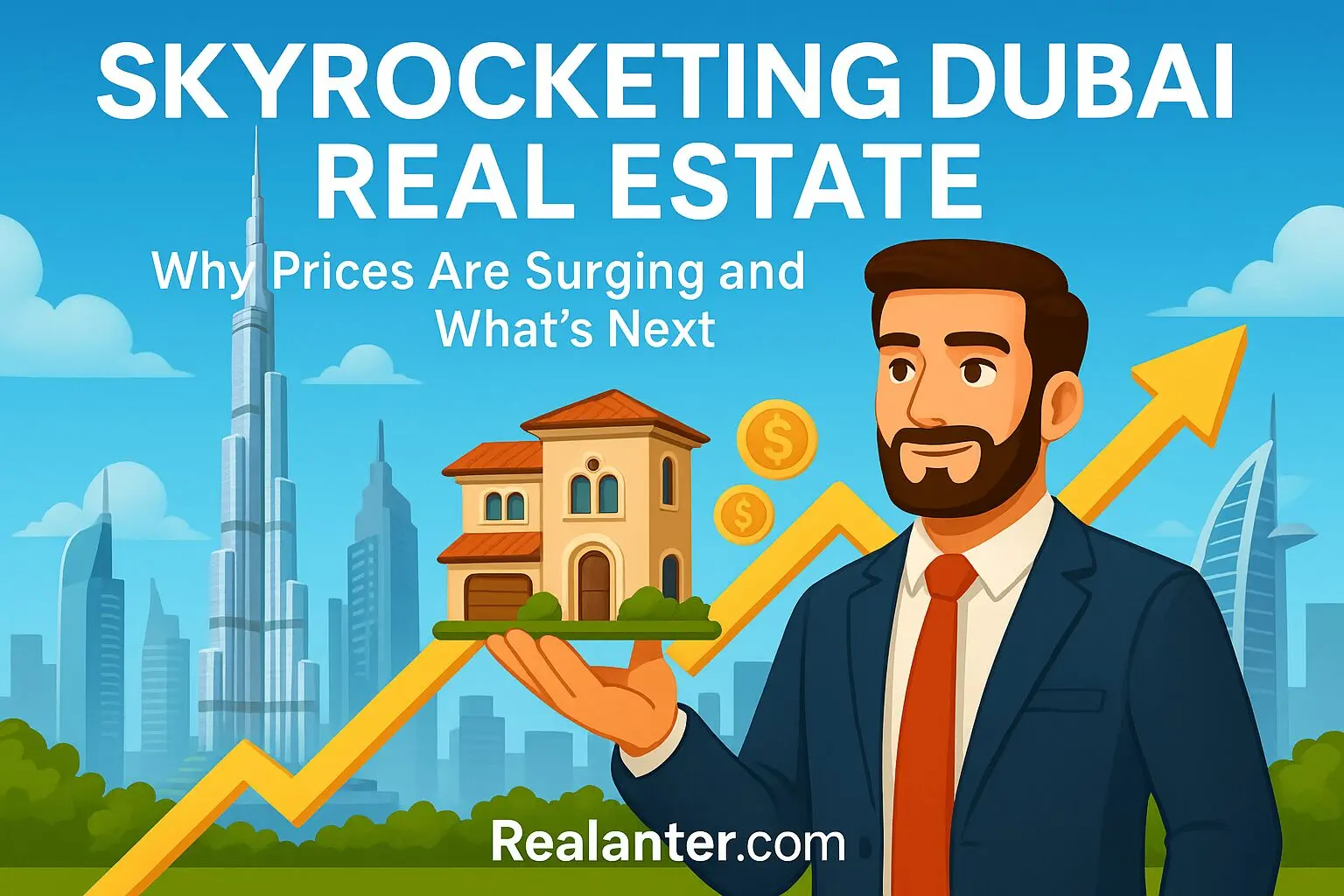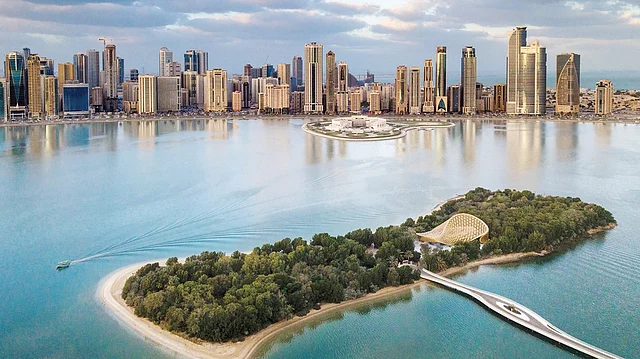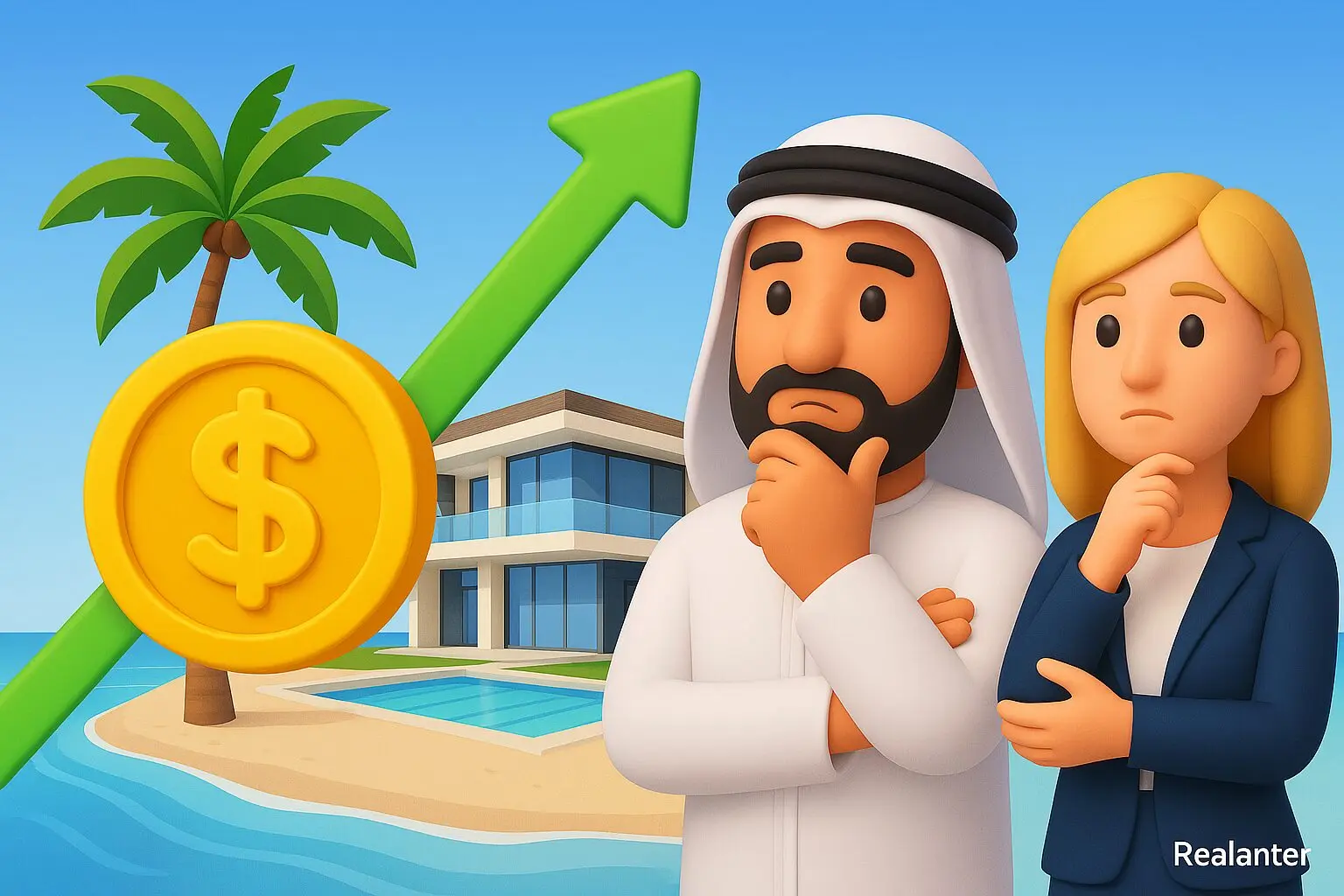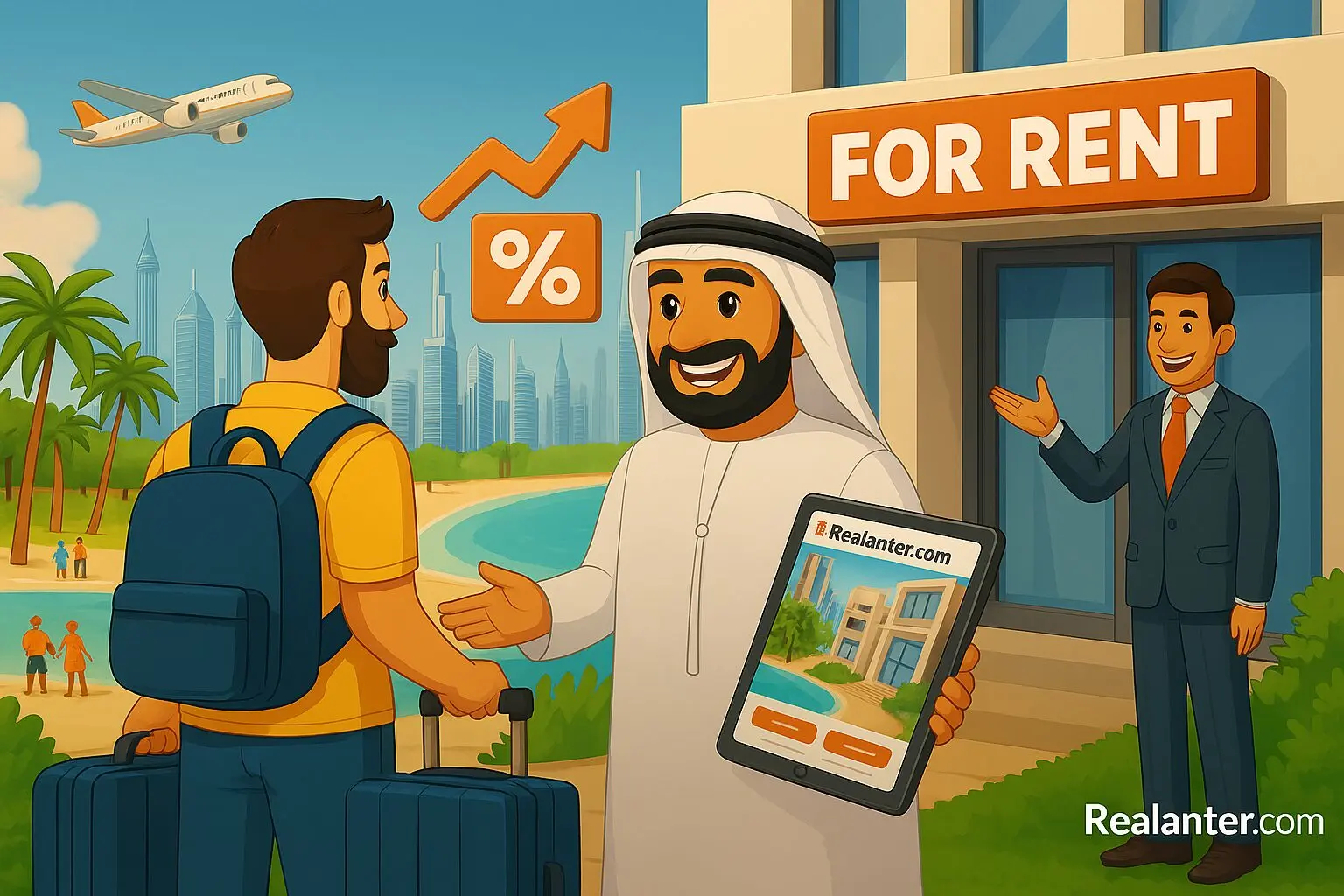In 2024, the property market of Dubai broke records with more than 151,000 transactions worth AED 441.5 billion, representing a 30% year-over-year increase. Dubai property price trends 2025 indicate ongoing growth, as predictions forecast a 5-8% per annum price growth. But what drives this unabating increase in property prices in Dubai 2025, and is it sustainable?
Key Drivers of the Price Increase
Several interconnected drivers are behind why Dubai property is increasing in price, from foreign investor demand to domestic policy shifts. Below, we break down the key drivers.
1. Foreign Investor Demand
The growth of the Dubai real estate market is highly dependent on overseas investments. The British and Asian investors and Saudi buyers accounted for 95% of Palm Jumeirah ownership in 2024. British investors account for over 15% in Dubai real estate. Foreign investors are drawn to Dubai by its hospitable environment of investments with tax-free property and extended visa periods thus appealing to wealthy individuals around the world. The luxury property sales in Dubai amounted to over 948 transactions (AED 15M+) in the first half of the year 2024 based on Knight Frank data, outpacing both London and New York.
According to the Chairman of DAMAC Properties Hussain Sajwani, Dubai stands out to investors because it is demonstrating resilience and providing exemption from taxation to usher in substantial profits.
2. Economic Recovery & Tourism Expansion
The economic growth of the UAE has been one of the driving forces for real estate prices trending upwards. The non-oil-based economies of finance, technology, and tourism are anticipated by the UAE Central Bank to lead 2025 GDP growth to 4.4%. The overnight visitor arrivals during the year amounted to 18.7 million for Dubai in 2024, which is up by 9% from the level of 2023, fuelling demand for residential flats as well as short-stay residences. Suburbs of Dubai Marina and Downtown Dubai and within tourism belts have seen price per square foot increase between up to 20%.
3. New Visa and Residency Reforms
The recent visa changes, i.e., Golden Visa (10-year residence for AED 2M+ real estate investment) and Blue Visa for environmentalists, have spurred demand. These initiatives attract professionals, retirees, and remote workers, increasing housing demand in Dubai. In 2024, the Dubai Land Department recorded a 33.3% increase in investor numbers, most of whom credited the incentive as a key driver.
4. Lack of Prime Supply within Strategic Locations
Prime locations like Downtown Dubai, Business Bay, and Palm Jumeirah are facing a shortage of supply and demand. Knight Frank reports that there are barely 13,500 new units scheduled to be handed over in Q4 2024, much less than the historical average of 30,000 per year. It is this shortcoming of supply that drives Dubai real estate inflation, particularly in high-end segments, where Palm Jumeirah prices rose 20% year-on-year in 2024.
5. Off-Plan Frenzy and Comfort Payment Plans
Off-plan prices in Dubai are on fire with tempting payment plans being offered by developers like Emaar and DAMAC. Off-plan sales contributed 63% of sales in 2025 and the price increased by 53% from AED 1.2M in 2020 to AED 1.9M in 2023. Off-plan plans requiring only 10-20% down payment make it easier for people to invest in real estate in Dubai.
“Off-plan property gives investors great ROI and autonomy but demands that buyers research developer integrity,” remarks Farooq Syed, CEO Springfield Properties.
Is It a Bubble or a Long-Term Cycle?
The rapid appreciation of Dubai 2025 real estate prices puts the sustainability agenda to test. Is the market a bubble generated by speculative demand or is it a long-term cycle driven by fundamentals? Experts lean towards the latter argument, which quotes an array of stabilizers. Fundamentals supporting growth:
- Job Market Recovery: Dubai’s non-oil sectors added 100,000 jobs in 2024, boosting local purchasing power.
- Population Growth: The city’s population grew to over 3.825 million in 2024, projected to increase to 5.8 million by 2040 as per the Dubai 2040 Urban Master Plan.
- Low Property Taxes: No taxes on capital gains or rental income increase rental yield over property value.
- Interest Rate Stabilization: The UAE Central Bank predicts that rates will remain under control, which is positive for mortgage affordability.
Risks of a Bubble
There are also UAE property bubble risks warnings by analysts with sped-up price growth. X postings predict a crash following a 70% hike over a span of two years, particularly in the event of economic sentiment falling globally or secondary markets’ oversupply to the market. However, CBRE’s Q3 2024 report counters that 70% of newly launched units since 2022 have been sold, which is a sign of high absorption rates.
5-Year Price Index: Dubai Apartments & Villas
The following chart illustrates price action from 2020 to 2024, and projection for 2025.
| Year | Apartments (AED/sq.ft) | Villas (AED/sq.ft) | YoY Change (%) |
| 2020 | 1,100 | 1,500 | -5% |
| 2021 | 1,203 | 1,650 | +9% |
| 2022 | 1,350 | 1,900 | +12% |
| 2023 | 1,600 | 2,200 | +15% |
| 2024 | 1,920 | 2,650 | +20% |
| 2025* | 2,050 | 2,800 | +7% |
*Projected based on Knight Frank and CBRE forecasts
Which Markets Are Growing Quickest?
Some segments of Dubai residential property show improved performance in the forecasted property market price evolution up to 2025. The following section compares five locations through yearly price trends and square foot market prices:
- Downtown Dubai: Repeat favorite time and again due to tourism and luxury developments like Emaar’s The Oasis.
- Dubai Hills: Suitable for families with golf courses and parks and yields 7-9% rental return.
- JVC: Location of choice for top family communities, value-for-money villas and apartments.
- Palm Jumeirah: Leads the luxury market with $10M+ properties doubling transactions to $7.6B in 2023.
- Business Bay: Attracts professionals due to its location and office skyscrapers.
Will Prices Still Go Up in 2025–2026?
The 2025-2026 Dubai housing market forecast is based on a variety of different factors:
1. Future Supply
Around 41,000 units will be handed over in 2025 and 42,000 in 2026, up 80% from 27,000 in 2024. While this will balance price in mid-range segments, luxury segments like Palm Jumeirah will remain supply-restricted, pushing prices up.
2. Interest Rate Expectations
With level stabilizing interest rates across the world, mortgage affordability will improve, stemming demand. An unexpected spike, however, would destroy buyer confidence.
3. Global Economic Sentiment
Dubai’s reliance on foreign investment in Dubai real estate makes it sensitive to global downturns. A strong US or European economy would sustain investor inflows, while a recession could slow growth.
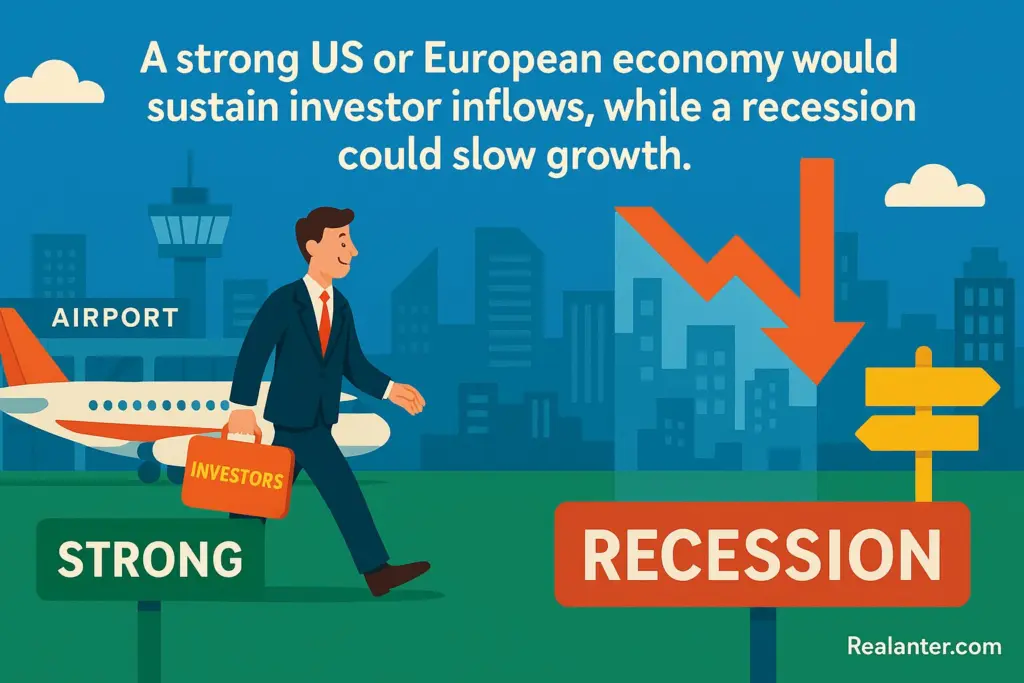
4. Developer Pricing Strategies
Developers are shifting toward sustainable development in Dubai, incorporating eco-friendly features like solar panels and smart home systems. This trend may increase off-plan prices in Dubai but attract eco-conscious buyers.
“Balancing growth with sustainability will be critical for Dubai’s long-term market stability,” says Akshay Nagdev, Managing Partner at Foremen Fiefdom.
Forecast: Experts predict 4-5% capital appreciation and 5-10% rental rate increases in 2025, with luxury segments potentially hitting 8% growth. The market is entering a mature growth phase, reducing bubble risks.
Investor Takeaways
Is now the right time to invest in real estate investment in Dubai? Here’s practical advice:
1. Timing the Market
Now: Appropriate for high-end investment in Downtown Dubai or Palm Jumeirah, with high demand and low supply.
Wait: Mid-market buyers would do well to wait until 2025-2026 handovers to hold prices in areas like JVC or Dubai South.
2. Off-Plan vs. Secondary
Off-Plan: Has superior ROI (7-10%) and flexible payment plans but has developer risk.
Secondary: Better suited for long-term use or short-term renting but with a greater initial price tag.
3. ROI vs. Price Appreciation
Rental Yields: Dubai Investments Park (returns of 11%) and JVC (9%) are locations of choice for rental yields.
Price Appreciation: Prime area locations like Palm Jumeirah offer 20%+ annual returns but require huge blocks of capital.
4. Expats vs. Residents’ Advice
Expats: Leverage visa advantages and invest in high-yielding locations for short-term tenancies.
Residents: Invest in family-oriented communities like Dubai Hills for long-term stay.
FAQs
While rapid growth raises bubble concerns, strong fundamentals like population growth and economic diversification point to a mature cycle rather than a speculative bubble.
Dubai Investments Park, JVC, and Dubai Silicon Oasis yield 9-11%, which is ideal for rental-driven investors.
Off-plan property offers flexibility and higher ROI at the cost of due diligence on developers. Ready property is safer to utilize as is.
Long-term visas like the Golden Visa stimulate demand for residential property in Dubai, particularly from HNWIs and specialists.
70% absorption rates for new properties, but over-supply risks are low, with chances of price stabilization in mid-segment space.
Final Words
Dubai property trend 2025 indicates that the market is pushed by foreign investment, economic growth, and policy liberalization. As a result of a potential fear of global economic shift or over-supply, nevertheless, there are inherent drivers of population growth, tourism, and discounting taxation to buffer appreciation. Investors must focus on high-demand areas like Palm Jumeirah or JVC, balance secondary and off-plan options, and select registered brokers to tackle Dubai market analysis. Dubai remains head of the class in real estate investment globally at 4-5% anticipated growth.

